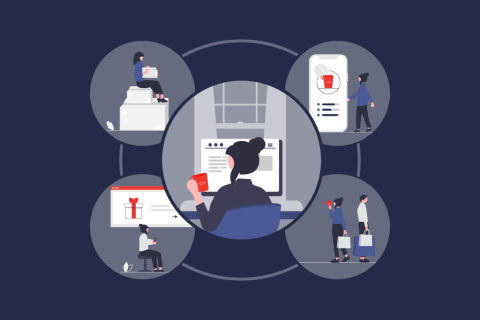Marketing
This is How You Generate Profit with Recommendation Marketing

Content
Inspire Customers with Targeted Recommendations
In stationary retail, good salespersons can usually make the difference between success and failure in sales. While a lot of energy is invested into the continuous training of individual store employees in stationary retail, the optimal product consulting for online shops is widely considered to be still a mere theory in the making. Here, customers are usually left to their own devices. Yet, there is such great potential in e-commerce just waiting to be put to good use. After all, customers always value a positive purchasing and product experience, regardless of physical or digital store. While it’s true that today’s shop systems offer features such as context-sensitive filters which allow users to find the right product among the overabundance of information, what usually falls flat is the product consulting as you know it from stationary stores. For example, store employees can provide you with good alternatives and accessories for what you’re looking for based on your previous visits and purchases. This doesn’t only translate into a positive purchasing experience for the customer but also more sales for the company. However, is it even feasibly possible to provide a purchasing experience in online commerce that is similar to stationary retail? The solution is to provide your customers with the right content as targeted recommendations. In short: Recommendation Marketing is the keyword. A simple solution to put this into practice is using a Recommendation Engine.
❓ What is a Recommendation Engine?
A Recommendation Engine is a tool for filtering data using AI-based algorithms and data about the browsing habits of your online shop’s visitors. Accordingly, the engine recommends relevant articles to visitors.
Everything’s a Matter of Taste? Score with Relevant Content
At different spots in your shop, further articles can be displayed to customers. Here, the decisive factor is relevance. Only if the products displayed fit your shop visitor’s taste can you motivate a purchasing decision. And this is also where the benefits of a good Recommendation Engine come into play. True, almost every shop system uses recommendations these days – yet they usually still lack in efficiency given the missing data foundation for recommending what is actually relevant in a given use case context. In fact, bad recommendations can even lead to frustration and, consequently, the canceling of the purchasing decision. A classic example for this is recommendations for products which aren’t available in the right size; such recommendations cause more harm than good.
Recommendations come in headlines like “You may also like…” or “People who buy this product also bought…”. While such headlines aren’t really catching your shop visitor’s attention anymore nowadays, the actual content still plays a significant role. The content must be spot on if you want to increase the probability of purchase and, consequently, the profitability of your web shop. The question what makes for suitable content isn’t easy to answer and shouldn’t be overgeneralized. Every human being has individual preferences and is interested in different products.
Personalized Content is King
To truly display what is relevant, information about the user’s movements and, ideally, also related actions are required. The more you know about your digital visitor, the easier will it be to personalize the respective content. In general, you can distinguish between two main strategies which you may also combine with one another for good recommendations.
1. The Recommendation Engine Processes Information about Users
Each visit, consumers leave trails which can be utilized for a precise product recommendation. For example, you can directly process information on what articles have been viewed in the past, what articles have been put into the shopping cart, and which articles have actually been bought into recommendations. How this data is put to use depends on the assortment of the respective shop. When it comes to consumables, it makes sense to recommend the same item again during the next visit; when it comes to products for daily use, in turn, already purchased articles should rather be excluded. The true heavyweight class, however, is using data about the past to predict future needs. Thanks to Predictive Analysis, you can use this data to calculate the so-called NBO (Next Best Offer).
In the process, a mathematical model analyzes a variety of past sessions to predict what will be bought next. So that recommendations may not only include matching products in this context, but also product categories or even editorial blogposts from the Content Marketing team, in order to create the optimal online shopping experience. Pursuant to data protection regulations, this kind of personalization requires explicit user consent. The standard method for getting the user’s consent is basic cookie banners which are already in use in every shop by default anyway.
2. Inferences Based on the Currently Viewed Article
For example, if somebody is browsing the product details page of a drilling machine, recommendations can be utilized to display other drills with similar properties or additional parts for upgrading the base product. Both translate into a higher customer satisfaction rate and more corporate sales. In particular, this is important when the article is accessed via Google or other search engines so that the user still lacks some context and information.
To guarantee optimal success, you should always combine both rule types in your shop. This way, you can display the right articles for products on the details page to users which exclude already purchased articles or show preferred NBO products from the corresponding product category. Furthermore, you can also consider further factors such as the current stock count or popularity and sales rate.
Data is the Alpha and Omega
The more information about shop visitors you have ready-to-hand, the more precise your recommendations will turn out to be. Engines also process, as discussed before, movement data such as information about viewed, bookmarked, and purchased articles. Such data is either put to use directly or the Recommendation Engine uses Artificial Intelligence to calculate the most relevant product based on probability and statistics.
The optimal rule or optimal formula as the “cure-all” for any possible use case doesn’t exist. The rule set and, consequently, the recommendations generated out of these rules must match the given use case of the visitor and must also be adjusted to the current phase of the Customer Journey the visitor is in. A visitor may be in the phase of checking the scope of available products or might already be looking for a concrete article – both phases require different recommendations.
In all cases, a Recommendation Engine can’t only help you in boosting the sales of you company, but can also help you to focus and guide the masses of visitors into the direction which is the most efficient for your shop and company. Two further examples on how to use targeted recommendations to support both your Online Marketing and Sales team at the click of few buttons are the preference for flagship products or giving more exposure to slow-selling articles. To make this run as smoothly as possible, consistent data is an absolute must-have. Imagine yourself trying to manually collect all the movement data about your customers together with all product data, to then distribute it into intended marketing channels. That’s simply impossible. In order to get your data in top form in the most resource-efficient manner possible, it’s worth assessing whether a PIM can further your corporate growth. PIM functions as the central datahub for your entire product content. Since everything is neatly pooled together and centralized, it’s a simple task to work on data collaboratively across multiple teams and distribute it into required channels. As you can see, generating more sales and optimizing both your Online Marketing and Product Management is far from witchcraft as long as you capitalize on the possibilities which digitalization brings to the table in a smart manner.
You want to dig deeper into this topic? In our webinar-on-demand, “Digital Product Information Management – Your Springboard to Digitalization,” eggheads product experts will demonstrate to you in 30 minutes how a PIM system can create the optimal basis to make profitable use of all benefits of digitalization.
From Our Blog
You may also be interested in the following articles







